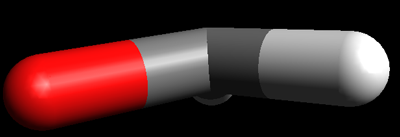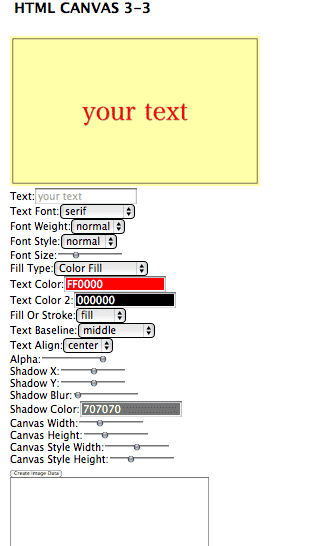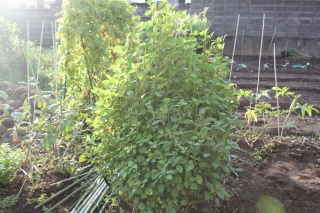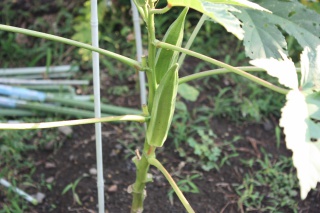27092011 javascript
面白そうなんだけど、本が積まれてて読む暇がない。
どうしたもんか。
11.09.27 追記
とかいいつつ、ざざっと一気に読んでしまった。これは良書でした。理解が曖昧だったところとかがきっちり書いてあったので理解が深まった。後ろの方のコードは流し読みしてしまったので、あとでちゃんと手を動かす予定。
あとできちんと書く。
27092011 javascript
面白そうなんだけど、本が積まれてて読む暇がない。
どうしたもんか。
とかいいつつ、ざざっと一気に読んでしまった。これは良書でした。理解が曖昧だったところとかがきっちり書いてあったので理解が深まった。後ろの方のコードは流し読みしてしまったので、あとでちゃんと手を動かす予定。
あとできちんと書く。
26092011 HTML5
3章は画像の扱い方。アイコンをタイル型に並べた画像ファイルを用意しておいて、任意の部分を切り出してCanavasに貼り付けたりアニメーションさせたりと、動くものをができるのは結構楽しい。
が、この本のサンプル画像が用意されていないのでちょっと困った。

 HTML5 Canvas: Native Interactivity and Animation for the Web
HTML5 Canvas: Native Interactivity and Animation for the WebExpress+jade+coffeeで書いたのはGitHubにあげている。
ドット絵ブームが来る予感がしてきた。
24092011 Scala
S-99を解く。List.makeを使ったらdeprecation warningsがでたので、fillにしてみたんだけどこれでいいのだろうか?
scala> List.make(5,3) warning: there were 1 deprecation warnings; re-run with -deprecation for details res5: List[Int] = List(3, 3, 3, 3, 3)
pythonのenumerateはscalaではzipWithIndexでこれを使えばp16は
ls.zipWithIndex filter { v => (v._2 + 1) % n != 0 } map { _._1 }
splitAtメソッド使えばリストを2つに分割(P17)できるが、僕はtakeとdrop使ってた。
 Scalaスケーラブルプログラミング[コンセプト&コーディング] (Programming in Scala)
Scalaスケーラブルプログラミング[コンセプト&コーディング] (Programming in Scala)//11 def pack[A](ls:List[A]): List[List[A]] = ls match { case Nil => Nil case head::tail => ls.takeWhile(_ == head) :: pack(tail.dropWhile(_ == head)) } def encodeModified[A](ls: List[A]): List[Any] = pack(ls) map { e => if (e.length == 1) e.head else (e.length, e.head) } println("s11: " + encodeModified(List('a, 'a, 'a, 'a, 'b, 'c, 'c, 'a, 'a, 'd, 'e, 'e, 'e, 'e))) //12 //scala> List.make(5,3) //warning: there were 1 deprecation warnings; re-run with -deprecation for details //res5: List[Int] = List(3, 3, 3, 3, 3) def decode[A](ls:List[(Int, A)]): List[A] = ls flatMap {e => List.fill(e._1)(e._2)} println("s12: " + decode(List((4, 'a), (1, 'b), (2, 'c), (2, 'a), (1, 'd), (4, 'e)))) //13 def encodeDirect[A](ls:List[A]): List[(Int, A)] = ls match { case Nil => Nil case head::tail => (ls.takeWhile(_ == head).length, head) :: encodeDirect(tail.dropWhile(_ == head)) } println("s13: " + encodeDirect(List('a, 'a, 'a, 'a, 'b, 'c, 'c, 'a, 'a, 'd, 'e, 'e, 'e, 'e))) //14 def duplicate[A](ls:List[A]): List[A] = ls match { case Nil => Nil case h::t => h::h::duplicate(t) } println("s14: " + duplicate(List('a, 'b, 'c, 'c, 'd))) //15 def duplicateN[A](n:Int, ls:List[A]): List[A] = ls flatMap {e => List.fill(n)(e) } println("s15: " + duplicateN(3, List('a, 'b, 'c, 'c, 'd))) //16 // // Functional. // def dropFunctional[A](n: Int, ls: List[A]): List[A] = // ls.zipWithIndex filter { v => (v._2 + 1) % n != 0 } map { _._1 } //} def drop[A](n:Int, ls:List[A]): List[A] = { def drop2[A](n:Int, ls:List[A]): List[A] = ls match { case Nil => Nil case _ => ls.take(n-1) ::: drop2(n, ls.drop(n)) } drop2(n,ls) } println("s16: " + drop(3, List('a, 'b, 'c, 'd, 'e, 'f, 'g, 'h, 'i, 'j, 'k))) //17 // Builtin. // def splitBuiltin[A](n: Int, ls: List[A]): (List[A], List[A]) = ls.splitAt(n) def split[A](n:Int, ls:List[A]): (List[A],List[A]) = (ls.take(n), ls.drop(n)) println("s17: " + split(3, List('a, 'b, 'c, 'd, 'e, 'f, 'g, 'h, 'i, 'j, 'k))) //18 def slice[A](s:Int, e:Int, ls:List[A]): List[A] = ls.take(e).drop(s) println("s18: " + slice(3, 7, List('a, 'b, 'c, 'd, 'e, 'f, 'g, 'h, 'i, 'j, 'k))) //19 def rotate[A](n:Int, ls:List[A]): List[A] = { if (n >= 0) ls.drop(n) ::: ls.take(n) else ls.drop(ls.length + n) ::: ls.take(ls.length + n) } println("s19: " + rotate(3, List('a, 'b, 'c, 'd, 'e, 'f, 'g, 'h, 'i, 'j, 'k))) println("s19: " + rotate(-2, List('a, 'b, 'c, 'd, 'e, 'f, 'g, 'h, 'i, 'j, 'k))) //20 def removeAt[A](n:Int, ls:List[A]): (List[A],A) = { val v = ls.splitAt(n) (v._1 ::: v._2.tail, v._2.head) } println("s20: " + removeAt(1, List('a, 'b, 'c, 'd)))
光異性化とかAMES予測とか代謝予測とか、量子化学計算が創薬シーンで果たす役割が大きくなっているのは、探索創薬自体が発見学というよりはメカニズムベースでモノを考えるようになってきているからかなぁと。それからFMOなんかも重要な技術ですね。
さて、ちょっと励起状態での構造最適化計算が必要になったので、pygamessでCIS計算できるようにしておきました。
test用にGAMESSのEXAM34のホルムアルデヒドの励起状態計算のサンプルを使っています。GAMESSで計算する場合にはpc-chem.infoのホルムアルデヒドの励起状態計算が参考になります。こういう良質なコンテンツもっと増えてくんないかな。
input用のmol
exam34_energy.log OpenBabel09231115413D 4 3 0 0 0 0 0 0 0 0999 V2000 0.0100 -0.8670 0.0000 O 0 0 0 0 0 0 0 0 0 0 0 0 0.0000 0.3455 0.0000 C 0 0 0 0 0 0 0 0 0 0 0 0 -0.0100 0.9296 -0.9377 H 0 0 0 0 0 0 0 0 0 0 0 0 -0.0100 0.9296 0.9377 H 0 0 0 0 0 0 0 0 0 0 0 0 1 2 2 0 0 0 0 2 4 1 0 0 0 0 3 2 1 0 0 0 0 M END
計算用スクリプト
import pygamess import openbabel as ob g = pygamess.Gamess() obc = ob.OBConversion() obc.SetInAndOutFormats("mol","mol") mol = ob.OBMol() obc.ReadFile(mol, "h2co.mol") g.contrl['cityp'] = 'cis' g.run_type('optimize') g.basis_type('631+gdp') g.gamess_input(mol) newmol = g.run(mol) print newmol.GetEnergy() obc.WriteFile(newmol,'h2co_singlet.mol')
励起状態のホルムアルデヒドの安定構造は若干ピラミッド型の構造を取るって知ってた?

ところで、光異性化のサンプルとして面白いのはやっぱスチルベンかなぁと思ったんだけど、HOMO-LUMOの2電子励起を考慮しないといけないらしいので、CISじゃ計算できないじゃんと。
もう少し面白いサンプルないかなぁ。
23092011 Scala
S-99を解く。Scalaは基本は関数型で考えて、どうしようもないときにはOOPに逃げられるのがいいですね。
 Scalaスケーラブルプログラミング[コンセプト&コーディング] (Programming in Scala)
Scalaスケーラブルプログラミング[コンセプト&コーディング] (Programming in Scala)//1 def last[A](ls:List[A]): A = ls.last println("s1: " + last(List(1, 1, 2, 3, 5, 8))) //2 def penultimate[A](ls:List[A]): A = ls.init.last println("s2: " + penultimate(List(1, 1, 2, 3, 5, 8))) //3 def nth[A](n:Int, ls:List[A]): A = if (n == 0) ls.head else nth(n-1,ls.tail) println("s3: " + nth(2, List(1, 1, 2, 3, 5, 8))) //4 def length[A](ls:List[A]): Int = ls.length println("s4: "+ length(List(1, 1, 2, 3, 5, 8))) //5 def reverse[A](ls:List[A]): List[A] = { def reverse2[A](ls:List[A],ls2:List[A]): List[A] = ls match { case Nil => ls2 case (head::tail) => reverse2(tail,head::ls2) } reverse2(ls,Nil) } println("s5: " + reverse(List(1, 1, 2, 3, 5, 8))) //6 def isPalindrome[A](ls:List[A]): Boolean = ls == reverse(ls) println("s6: " + isPalindrome(List(1, 2, 3, 2, 1))) //7 def flatten(ls: List[Any]): List[Any] = ls flatMap { case ms:List[_] => flatten(ms) case e => List(e) } println("s7: " + flatten(List(List(1, 1), 2, List(3, List(5, 8))))) //8 def compress[A](ls:List[A]): List[A] = ls match { case Nil => ls case head::tail => head::compress(tail.dropWhile(_ == head)) } println("s8: " + compress(List('a, 'a, 'a, 'a, 'b, 'c, 'c, 'a, 'a, 'd, 'e, 'e, 'e, 'e))) //9 def pack[A](ls:List[A]): List[List[A]] = ls match { case Nil => Nil case head::tail => ls.takeWhile(_ == head) :: pack(tail.dropWhile(_ == head)) } println("s9: " + pack(List('a, 'a, 'a, 'a, 'b, 'c, 'c, 'a, 'a, 'd, 'e, 'e, 'e, 'e))) //10 def encode[A](ls: List[A]): List[(Int, A)] = pack(ls) map {e => (e.length, e.head)} println("s10: " + encode(List('a, 'a, 'a, 'a, 'b, 'c, 'c, 'a, 'a, 'd, 'e, 'e, 'e, 'e)))
22092011 Linux
Linuxカーネル2.6解読室の流れで読み始めた。
Linuxも色々勉強しておかないといけない。
そしてこれはまだ読んでいない、積んである。
21092011 HTML5
3章はテキストの扱い方。プロパティをインタラクティブにいじれるものを作りながらText属性に関して学んでいく感じ。これといって難しい所はなくて、さくっとこなした。

 HTML5 Canvas: Native Interactivity and Animation for the Web
HTML5 Canvas: Native Interactivity and Animation for the WebExpress+jade+coffeeで書いたのはGitHubにあげている。
21092011 Python
プログラミングコンテストチャレンジブックから
高々|V|-1回で最安定経路にたどり着くっていうのがなかなか理解できなくて、紙に書きながら理解した。
edge = [[0,1,2],[0,2,5],[1,2,4],[1,3,6],[1,4,10],[2,3,2],[3,5,1],[4,5,3],[4,6,5],[5,6,9], [1,0,2],[2,0,5],[2,1,4],[3,1,6],[4,1,10],[3,2,2],[5,3,1],[5,4,3],[6,4,5],[6,5,9]] def shortest_path(edge,num_v,start): inf = float("inf") d = [inf for f in range(num_v)] d[start] = 0; while True: update = False for e in edge: if d[e[0]] != inf and d[e[1]] > d[e[0]] + e[2]: d[e[1]] = d[e[0]] + e[2] update = True if not update: break return d print shortest_path(edge,7,0)[6]
こっちは馴染み深い
edge = [[0,1,2],[0,2,5],[1,2,4],[1,3,6],[1,4,10],[2,3,2],[3,5,1],[4,5,3],[4,6,5],[5,6,9], [1,0,2],[2,0,5],[2,1,4],[3,1,6],[4,1,10],[3,2,2],[5,3,1],[5,4,3],[6,4,5],[6,5,9]] def dijkstra(edge,num_v,start): inf = float("inf") cost = [[inf for i in range(num_v)] for j in range(num_v)] for e in edge: cost[e[0]][e[1]] = e[2] used = [False for i in range(num_v)] d = [inf for j in range(num_v)] d[start] = 0; while True: v = -1 for u in range(num_v): if (not used[u]) and (v == -1 or d[u] < d[v]): v = u if v == -1: break used[v] = True for x in range(num_v): d[x] = d[x] if d[x] < d[v] + cost[v][x] else d[v] + cost[v][x] print d return d[num_v-1] print dijkstra(edge,7,0)
最短経路の本もいいっすね。数学ガールとともに子供の為にとってある。
20092011 家庭菜園
苗木屋に行ってにんにくを調達したついでに、今から植えるのになにがいいかなと質問したら、人参植えとけって言われたので、ひとみ五寸っていう種類を買って早速撒いてきた。 (次の日雨降ってどうしようもないので、昨日のうちに種まいておいて正解だった。)
レーキが欲しかったのでついに購入。

モロヘイヤは成長が鈍ってきた。そろそろ終了かも。

おくらは思ったより収穫量が少なかった。来年はもっと早くから種をまこう。

ゴーヤは種取り用に少し残してある。熟したのを家に持って帰ると虫が入ってたりして、嫌がられるので、このままにしておいて、地面にこぼれた種を拾うのが楽でいい。

あと、ゴーヤを処分したいときには、根っこを引きぬいて何日かほうっておくと、良い感じに枯れてくれるので 処分が楽ですね。
19092011 御殿場